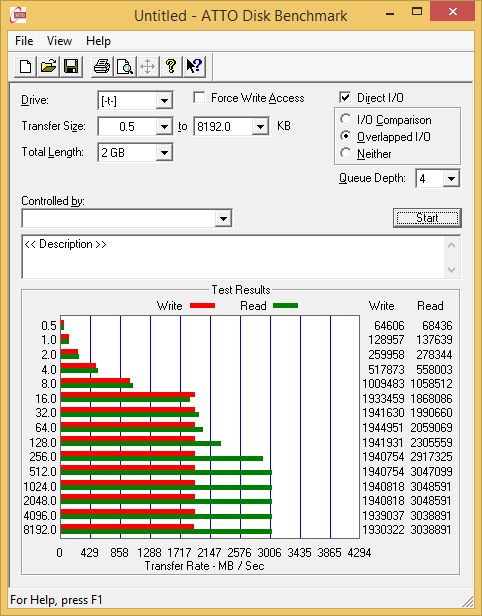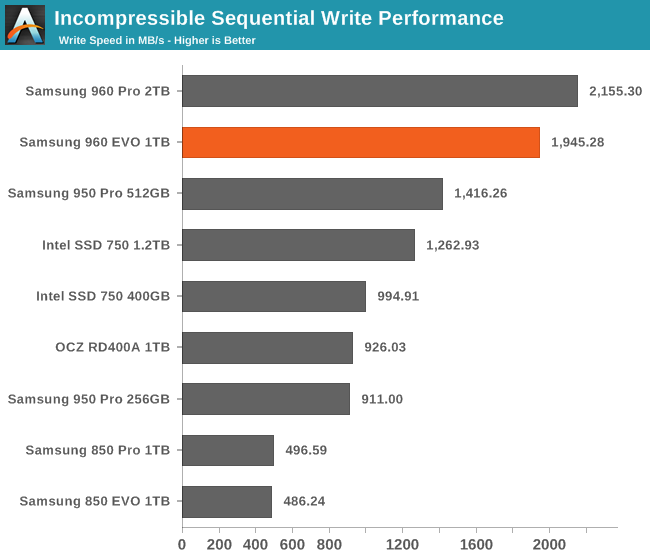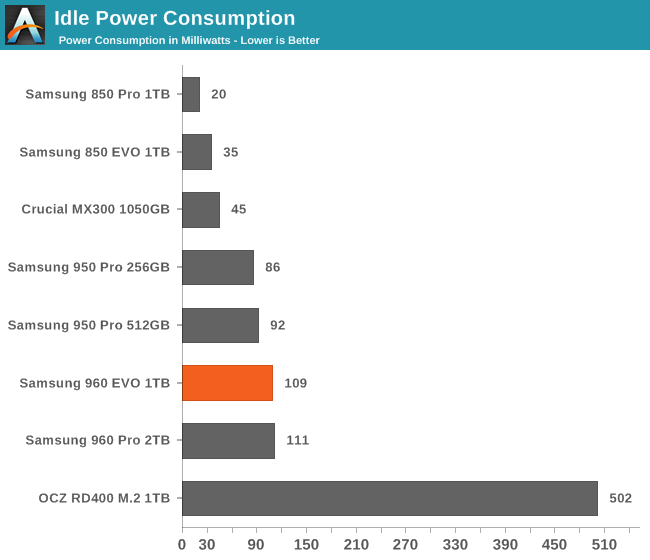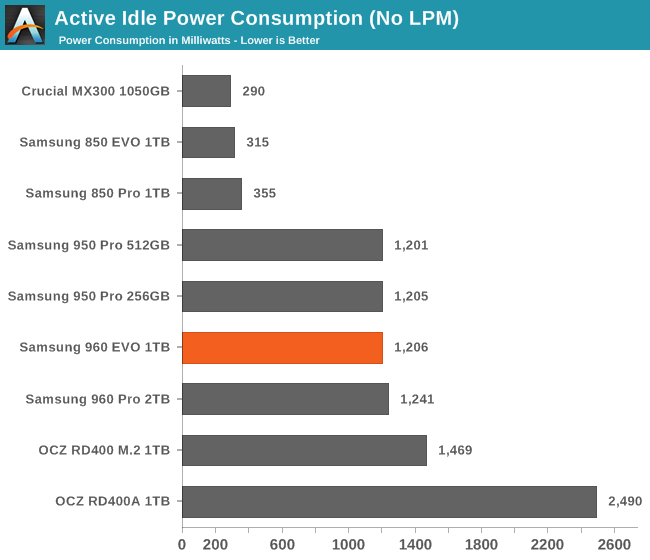The Samsung 960 EVO (1TB) Review
by Billy Tallis on November 15, 2016 10:00 AM ESTATTO
ATTO's Disk Benchmark is a quick and easy freeware tool to measure drive performance across various transfer sizes.
 |
|||||||||
By the end of the test, the 960 EVO and 960 Pro are performing identically. The 960 EVO takes longer to get up to full read speed, and the 960 Pro turns in some slightly better write speeds before thermal throttling levels things out.
AS-SSD
AS-SSD is another quick and free benchmark tool. It uses incompressible data for all of its tests, making it an easy way to keep an eye on which drives are relying on transparent data compression. The short duration of the test makes it a decent indicator of peak drive performance.


Both AS-SSD sequential tests show that the 960 EVO's peak performance really is second only to the 960 Pro, even if in longer tests some other models are able to outperform the 960 EVO.
Idle Power Consumption
Since the ATSB tests based on real-world usage cut idle times short to 25ms, their power consumption scores paint an inaccurate picture of the relative suitability of drives for mobile use. During real-world client use, a solid state drive will spend far more time idle than actively processing commands. Our testbed doesn't support the deepest DevSlp power saving mode that SATA drives can implement, but we can measure the power usage in the intermediate slumber state where both the host and device ends of the SATA link enter a low-power state and the drive is free to engage its internal power savings measures.
We also report the drive's idle power consumption while the SATA link is active and not in any power saving state. Drives are required to be able to wake from the slumber state in under 10 milliseconds, but that still leaves plenty of room for them to add latency to a burst of I/O. Because of this, many desktops default to either not using SATA Aggressive Link Power Management (ALPM) at all or to only enable it partially without making use of the device-initiated power management (DIPM) capability. Additionally, SATA Hot-Swap is incompatible with the use of DIPM, so our SSD testbed usually has DIPM turned off during performance testing.


Idle power for the 960 EVO is the same as for the 960 Pro. Our usual testbed configuration does not engage any explicit power saving modes so the 960 EVO idles at 1.2 W where most SATA drives will draw much less than 1W. On systems that make use of NVMe power saving capabilities, idle power will be only a few times higher than the best SATA drives, and this is without making full use of PCIe link power management.










87 Comments
View All Comments
DanNeely - Tuesday, November 15, 2016 - link
The Intel 750 doesn't have power data in Bench. My guess would be that the current power benchmarks post-date when the review sample was returned.Sometimes there are oversights, but most of the time when some devices are only shown in a subset of the charts its because data to score them on the others isn't available. Most often due to moving testsuite targets or breaking changes in the benchmark applications.
http://www.anandtech.com/bench/SSD15/1440
http://www.anandtech.com/bench/product/1458
Billy Tallis - Tuesday, November 15, 2016 - link
Yeah, the Intel 750 was tested by Kristian before we had working PCIe power measurement. It also complicates things by using both the 12V and 3.3V rails, when I only have one meter. Adding power consumption data isn't a high priority for me, because the Intel 750 is always in last place, by a lot: its idle power is higher than the load power of most M.2 drives on many of the tests. The Intel 750 would distort the scale of the power graphs to the point that it would be hard to see the differences between the M.2 drives.willis936 - Tuesday, November 15, 2016 - link
How are M.2 drives mounted during these reviews? Do you use the motherboard's M.2 connector? A PCIe adapter without a heatsink? A PCIe adapter with a heatsink?Billy Tallis - Tuesday, November 15, 2016 - link
Unless otherwise specified, M.2 PCIe drives are tested in a simple Lycom DT-120 adapter, which is connected to the riser card used for power measurement, which is in turn connected to the primary PCIe 3.0 x16 slot. Drives like the OCZ RD400A and Plextor M8PeY are also tested in their bundled adapter cards with whatever heatsink that provides, and any other M.2+heatsink results I report are using the Angelbird Wings PX1 adapter and heatsink.R3MF - Tuesday, November 15, 2016 - link
Is that v2.0 driver available on day one?(for Windows7 users wanting to do a fresh install)
CrazyElf - Tuesday, November 15, 2016 - link
First, it is the drive that will likely play a role in making M.2 SSDs a much more popular form factor, perhaps to the point where NVMe drives overtake SATA. Most people do not need the write endurance that the MLC SSDs have.Second, the performance is quite good, and although there is still a huge price premium over SATA SSDs, the massive performance increase is much more justifiable in terms of cost premium compared to say, the 960 Pro, which is for people who want the best. It will remain that way, until the 970 Pro and Evo come out, or perhaps until a 3D XPoint SSD comes out.
Third, I expect an enterprise version to come out too, with power loss protection. The only real issue i see is if there is something like the 840 Evo that caused performance drops, but so far Samsung's TLC drives since then have been solid.
TheinsanegamerN - Tuesday, November 15, 2016 - link
I believe the 840 evo was planar NAND, whereas the newer designs are 3D NAND. That may be part of the reason.XabanakFanatik - Tuesday, November 15, 2016 - link
I see no mention of Samsung's silent delays of these drives. As of now most models of both the pro and evo are listed as ship by late December or January.Kind of disappointing you would gloss over a 2-3 month delay like that.
haukionkannel - Tuesday, November 15, 2016 - link
It seems that Samsung was lucky that their 250GB unit did fail...http://www.tomshardware.com/reviews/samsung-960-ev...
It seems to completely another series than 1Tb version.
TheinsanegamerN - Tuesday, November 15, 2016 - link
What are you trying to say here?